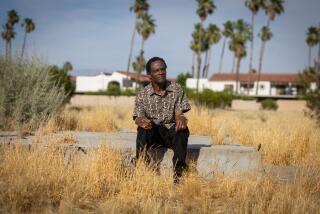Plane Crash May Spell End of Subdivision : Santa Paula: Homeowners will probably not be allowed to rebuild. They wait for insurance claims and the city’s decision to buy the land.
When a crippled plane plunged to earth in Santa Paula on Aug. 27, killing the pilot and destroying two homes, the fiery crash may also have hastened the end of the little neighborhood where the plane fell.
Because the working-class neighborhood is within a newly created safety zone next to the Santa Paula Airport, officials say the owners of the demolished homes will probably never be allowed to rebuild.
And because of the state’s continuing budget woes, officials say they don’t know when the city of Santa Paula will be able to buy the debris-covered lots owned by Joseph Garcia and Rafael Rodriguez.
Meanwhile, insurance claims by the two men cannot be settled completely until federal transportation officials determine who was at fault in the collision of two small planes.
“Every time I talk about it, it gets worse and worse,” said Garcia, whose application to rebuild the house he rented to a son was rejected last month by the Ventura County Airport Land Use Commission.
Garcia, 72, relied on the $900 monthly rent from the Santa Clara Street house to supplement the pension he receives as a retired carpenter. He and his wife, Emily, live next door in a house he built with his own hands in 1948.
The other burned-out house was also an income property that Rodriguez, a retired laborer, rented out to bolster his pension.
The gutted houses are among two dozen that lie within a 1,200-foot safety zone that the Ventura County Transportation Commission created a year ago around the privately owned Santa Paula Airport.
To facilitate Santa Paula’s eventual purchase of the affected houses, Assemblyman Jack O’Connell (D-Carpinteria) sponsored a bill that allows state funds to be used to buy property near private airports. Before the county can apply for the funds, however, Santa Paula officials must restrict construction in the safety area by changing the zoning.
City officials expect to complete that task within a few months, but transportation officials say it will be at least six months before state funds could be obtained and much longer delays are possible.
More than 10 weeks after the fatal crash, the scene looks much like it did the day after the accident. Blackened rubble still covers the ground within the skeletal remains of the two houses, with charred scraps from a high school yearbook and soot-covered appliances still recognizable.
Cut off from the rest of Santa Paula when the Santa Paula Freeway was built, the modest subdivision is close to the Santa Clara River and has been damaged by periodic floods since it was first developed in 1922.
In 1928, when the St. Francis Dam in Francisquito Canyon burst some 50 miles upstream, the resulting flood wiped out houses in the low-lying community. The house Garcia eventually bought was built in 1928, and the Rodriguez house a year later. Both were built before the nearby Santa Paula Airport opened in 1930.
Garcia’s wife, Emily, said she was reluctant to live so close to the airport when the couple moved there after World War II, but she stopped protesting as the couple’s five children grew up in the house.
“Our children liked it because of the river being so close and they liked to fish and hunt,” she said during an interview at the family’s surviving home. “They had fun here.”
But the fun ended with the crash, Joseph Garcia said.
“After the accident, it seems like most of my family doesn’t want to live here anymore,” he said. Danny Garcia was hospitalized for smoke inhalation after he tried in vain to save the life of the pilot, William L. Clark, who died in the crash. And Esther, Danny’s wife, has been treated for shock and anxiety since the plane crashed through the roof of the couple’s house as they sat in the living room.
Joseph Garcia said he too has lived with fear since the crash.
“When I’m sleeping, I wake up every time I hear a plane landing or a truck pass by on the freeway,” he said. “I wake up 10 times a night.”
Garcia said he is increasingly frustrated by his inability to receive compensation for his loss. He estimates it would cost $13,000 to clean away the rubble and another $180,000 to plan and rebuild a house.
So far, insurance companies he has negotiated with have offered only a $69,000 settlement pending a decision by federal investigators as to which of the two pilots was at fault in the crash, he said. The investigators were unavailable Monday to discuss the status of the case.
“I don’t give a damn whose fault it is,” Garcia said. “The plane came out of the sky and hit my house; my house didn’t come off the foundation and hit the plane.”
Ginger Gherardi, the executive director of the county Transportation Commission, said she is “fairly confident” that state money will become available to buy the two lots.
Although state funds for state airport projects were cut by 90% in the current budget, Gherardi said, the Santa Paula project may be able to tap into grant money that has been approved for other projects but is not yet needed. The state Transportation Commission would have to approve such a transfer.
Arnold Dowdy, Santa Paula’s city administrator, said if state funding proves elusive, the needed funds could come out of Santa Paula’s new redevelopment agency.
“I’m positive we can do something for the families before too long,” Dowdy said.
Garcia said he is losing patience.
“They’d better hurry up because I’m getting too old,” he said.
More to Read
Sign up for Essential California
The most important California stories and recommendations in your inbox every morning.
You may occasionally receive promotional content from the Los Angeles Times.










